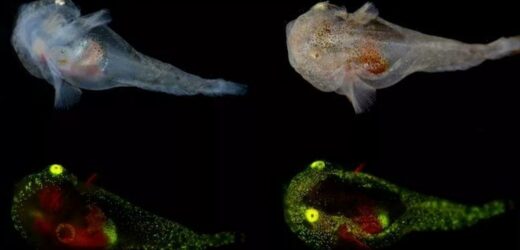For out-of-this-world news, sign up for the Spaced Out newsletter
We have more newsletters
An extra-terrestrial-looking fish has been found by scientists drilling deep into an Arctic iceberg.
The juvenile variegated snailfish looks like a tadpole but with one very obvious difference – it glows bright green.
This is due to its blood which contains the "highest expression levels" of anti-freeze proteins ever found, according to a new study.
READ MORE: World's first stag do for dogs allows grooms to enjoy boozy 'pup crawl' with pals
David Gruber, a research associate at the American Museum of Natural History and a distinguished biology professor at City University of New York's Baruch College said: "The snailfish was one of the few species of fish living among the icebergs, in the crevices.
"It was surprising that such a tiny fish could live in such an extremely cold environment without freezing."
Gruber, the study's co-author, added: "Antifreeze proteins stick to the surface of smaller ice crystals and slow or prevent them from growing into larger, and more dangerous, crystals.
"Fish from both the North and South Poles independently evolved these proteins."
The bright green glow is an evolutionary tactic that helps maintain the fish's body temperature in its icy environment, in the same way antifreeze helps to regulate the temperature of a car's engine in very cold temperatures.
The proteins were first discovered in animals 50 years ago when researchers discovered species of Antarctic fish that had developed the technique to help them survive.
Unlike cold-blooded reptiles and insects, fish can't survive if their body temperature drops and their bodily fluids freeze, so those who dwell in colder climates have had to find ways to keep themselves alive.
John Sparks, a curator in the AMNH's Department of Ichthyology and co-author of the study, said: "The fact that these different antifreeze proteins have evolved independently in a number of different — and not closely related — fish lineages show[s] how critical they are to the survival of these organisms in these extreme habitats."
For more incredible stories from the Daily Star, make sure you sign up to one of our newsletters here
These snailfish produce antifreeze proteins "like any other protein and then excrete them into their bloodstream," according to Gruber. But the glowing alien fish appear to be "making antifreeze proteins in the top 1% of all other fish genes."
And although the anti-freeze adaptation has been found before, this is the first reported case of an Arctic fish glowing in the way that the snailfish does.
Biofluorescence is caused when creatures are able to convert blue light into green, red, or yellow light – but since there are lengthy periods of darkness in the north and south poles, this characteristic is uncommon.
The ability to glow like this tadpole-esque is more commonly found in fish who live in warmer climates.
READ NEXT:
Creepy body of the 'Kraken' with 'dinner plate sized eyes' washes ashore
'Aggressive' kangaroos take over town as residents wield weapons to defend themselves
'Angry minion' without an anus is not actually our first ancestor, say scientists
Beachgoers stunned at huge jellyfish as they're warned 'you can look but don't touch'
- Animals
- Science
- Alien
Source: Read Full Article




